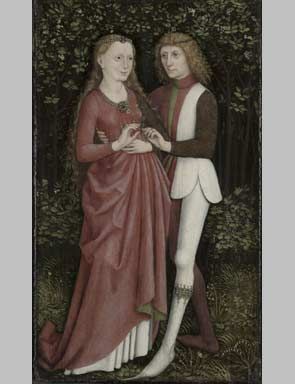"Medieval Treasures from the Cleveland Museum of Art" @ The Frist Center for the Visual Arts
A Bridal Pair, 1400s, South German, Oil on panel, 30 ½ x 20 1/16 x 2 15/16 in. The Cleveland Museum of Art, Delia E. Holden and L. E. Holden Funds.
NASHVILLE, TN.- The Frist Center for the Visual Arts will open Medieval Treasures from the Cleveland Museum of Art Friday, Feb. 13, 2009. The traveling exhibition provides an extraordinary opportunity to see more than 100 rare works of art from the Middle Ages. The wide array of objects includes ivories, enamels, metalwork, jewelry, sculptures, paintings and illuminated manuscripts produced in Europe and the Mediterranean basin. The Cleveland Museum of Art (Ohio) possesses one of the finest collections of Early Christian, Byzantine, and European Medieval art in the United States. Medieval Treasures will be on view through Sunday, June 7, 2009.
“Every object in Medieval Treasures is exquisite and is indicative of the extraordinary quality of the collection assembled by the Cleveland Museum of Art throughout the course of the past century,” says Trinita Kennedy, associate curator at the Frist Center for the Visual Arts. “The exhibition takes us back to a time and place when religious faith inspired artists to create objects of awe-inspiring beauty.”
Early Christian and Byzantine Treasures: Art and Empire - The exhibition begins with a group of rare early Christian sculptures. Marble statuettes of Christ as the Good Shepherd and the Old Testament prophet Jonah most likely date to 280–90, that is, several decades before Constantine the Great declared Christianity the official religion of the Roman Empire in 330. These sculptures eloquently express Christian beliefs in salvation and resurrection. Visitors will also see the Octagonal Pendant, one of the finest pieces of gold jewelry to survive from the reign of Constantine. Its center is mounted with a double solidus (gold coin) representing Constantine crowned as emperor. Important examples of Byzantine art will be on view, such as The Icon of the Virgin and Child (second half of the 10th or early 11th century), one of the most superb ivories to survive the Middle Byzantine period.
The exhibition features an entire gallery dedicated to the personal and portable art of the Migration period (approximately 300 to 900). In addition to silver, gold and bronze jewelry studded with garnets and pearls, there is a rare Celtic head made of sandstone intended for ritual veneration.
Early Medieval Treasures: Splendor and Devotion - During the 9th century, the Christianization of Celtic and Germanic tribes resulted in an increased demand for churches, monasteries, liturgical objects and illuminated manuscripts throughout Europe, but especially in Germany.
The Cleveland Museum of Art is renowned for its objects from the Guelph Treasure, one of the most important church treasuries to have survived from medieval Germany. The museum acquired these sacred objects in 1930. Included in the exhibition is one of the earliest and most sumptuous works from the treasure, the Portable Altar of Countess Gertrude, ca. 1045. Made of gold, cloisonné enamel, gems, pearls, oak and other materials, the altar is a masterpiece of early medieval goldsmith work.
High Gothic Treasures: Court and Cloister - Throughout the 11th and 12th centuries, powerful and wealthy monasteries emerged as Europe’s preeminent centers of artistic production and display. A selection of reliquaries, crosses, and large-scale sculptures in the exhibition were made for monasteries located in France and Germany. Major monasteries formed workshops of their own and created lavish manuscripts and illuminations using gold and other fine materials.
Late Medieval Treasures: Toward a New Expression - The exhibition concludes with four galleries filled with exquisite works from late medieval France, Burgundy, Italy, and Germany. French artisans (ca. 1130–1300) created illuminated books of hours, ivory reliefs and metalwork suited to the royal court’s need for extraordinarily refined luxury goods.
The dukes of Burgundy (1364–1477) sought to enhance their status with displays of wealth and taste, and became brilliant patrons of art. The exhibition features three alabaster sculptures of mourners, made between 1406 and 1410, for the tomb of Philip the Bold, Duke of Burgundy—one of the most celebrated funerary monuments of the Middle Ages. Also on view is a magnificent Table Fountain (ca. 1320–40), an object of great ingenuity intended to entertain the dinner guests of the Burgundian dukes.
The great mercantile centers of medieval Italy—namely, Siena, Florence, Bologna and Venice—were home to brilliant craftsmen who produced gold ground panel paintings and sculpted reliefs of the Madonna and Child and the saints. Most extraordinary is a large altarpiece from a Franciscan church that survives intact—one of only a few now in the United States.
The sculptors of late medieval Germany brought woodcarving to a high degree of sophistication, and the Cleveland Museum of Art possesses one of the largest collections of their work outside Europe. Examples in the exhibition range from a nearly life-sized Saint John Resting on the Bosom of Christ of polychrome oak by an anonymous artist to a small-scale mourning Virgin made of pear wood by Viet Stoss.
Medieval Treasures from the Cleveland Museum of Art was organized by the Cleveland Museum of Art.

/https%3A%2F%2Fprofilepics.canalblog.com%2Fprofilepics%2F1%2F0%2F100183.jpg)
/https%3A%2F%2Fstorage.canalblog.com%2F03%2F02%2F119589%2F96711876_o.jpg)
/https%3A%2F%2Fstorage.canalblog.com%2F11%2F31%2F119589%2F94773502_o.jpg)
/https%3A%2F%2Fstorage.canalblog.com%2F20%2F83%2F119589%2F94772815_o.jpg)
/https%3A%2F%2Fstorage.canalblog.com%2F26%2F72%2F119589%2F75604929_o.jpg)
/https%3A%2F%2Fstorage.canalblog.com%2F59%2F60%2F119589%2F26458628_o.jpg)



/http%3A%2F%2Fstorage.canalblog.com%2F93%2F12%2F119589%2F122358776_o.jpg)
/http%3A%2F%2Fstorage.canalblog.com%2F30%2F95%2F119589%2F115510984_o.jpg)
/http%3A%2F%2Fstorage.canalblog.com%2F38%2F91%2F119589%2F112085312_o.jpg)
/http%3A%2F%2Fstorage.canalblog.com%2F57%2F05%2F119589%2F111930948_o.jpg)